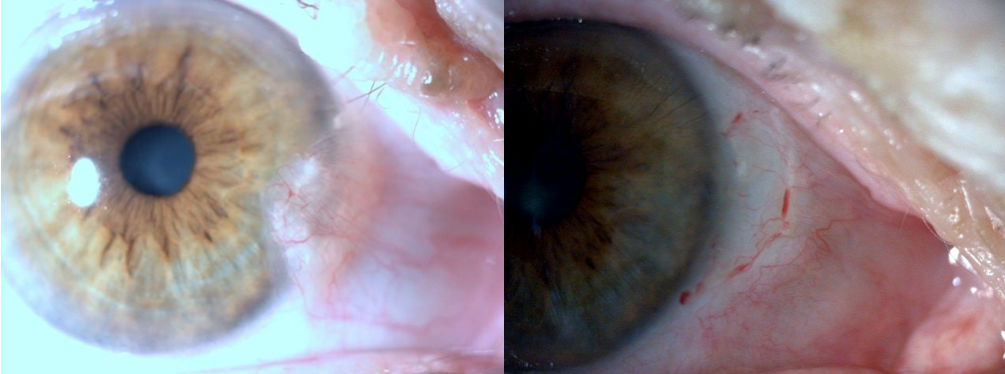Menu
David Anderson commonly performs other corneal surgeries including pterygium surgery and amniotic membrane transplant surgery. Book a consultation today and find out if you’re suitable.


A pterygium is a wing-like growth that arises from the nasal corner of the eye and grows across the cornea toward the pupil. Pterygia tend to occur in people who have lived or spent time in dusty environments with high UV light exposure.
This might vary from growing up in a hot, dry, sunny country, spending significant time enjoying activities such as sailing or skiing where there is high reflected UV or simply spending significant time outdoors in the sunshine.
David Anderson offers advanced techniques in the removal and repair of the ocular surface in pterygia including suture-less surgery and the use of mitomycin C and amniotic membrane in advanced or complex cases.
Although many people will be squeamish or nervous about pterygium surgery there is no need to be. Here at Anderson Eye Care, we are experienced in guiding through your procedure which will take place under local anaesthesia so that you will not be able to see or feel anything.
The procedure typically takes around 30 mins and afterwards a bandage contact lens will be placed in the eye to improve your comfort during recovery. The contact lens will be removed for you at your first post-operative checkup.
We suggest you allow 3-4 hours to attend the hospital to allow plenty of time to be admitted, undergo surgery, take some refreshments afterwards and run through your aftercare instructions. We ask you to arrange transport home on discharge as you should not drive.
We will cover your eye with a transparent protective shield and provide you with anti-inflammatory and antibiotic eyedrops to use. Initially these will need to be instilled quite frequently then slowly reduced over the next weeks.
Avoid getting tap water in your eye for the first week, wearing swimming goggles in the shower or taking a bath may be easier. Your first review will usually take place a week or so following surgery when your contact lens will be removed and you can return to normal activities.
We ask you to avoid rubbing or touching your eye for the next few weeks whilst healing takes place.
Here are some questions we are often asked regarding surgery and recovery. You may well have others that are not covered here so please do contact us to ask.
There will be plenty of time during your medical consultation to discuss surgery so that you can reach a fully informed decision.
We use a technique of removal combined with the placement of a barrier of healthy conjunctival tissue called CLAU (conjunctival limbal autograft) which reduces the risk of return or recurrence to under 10% and much lower still depending on type and duration of the pterygium. In advanced or more complex or recurrent cases, other advanced reconstruction techniques may be employed e.g. the use of Mitomycin C, an anti-scarring agent, or the use of amniotic membrane as an adjunct to healing.

Pterygium Surgery Before & After
Your eye will feel scratchy as if something were in it for a few days but will not be painful. You will have antibiotic and anti-inflammatory drops to use for some weeks which can also be combined with lubricant or wetting drops for additional comfort.
Initially your vision will be worse whilst the contact lens remains in place and you are in the immediate postoperative period. Your vision should then improve particularly if the pterygium caused high astigmatism. Astigmatism usually takes around 6 weeks to stabilize following surgery if you wished to update spectacles or proceed with another type of surgery e.g. cataract surgery or laser vision correction.
Nowadays, work usually involves the use of screens which will reduce your blink rate and dry your eyes making them feel less comfortable. This won’t affect the outcome of your surgery but your eye will feel gritty so we suggest a few days away from work immediately following the procedure. If you feel able to though, you can return to office work the next day or work from home.
We suggest a week away from the gym or exercise classes but you can still stretch and remain active by taking walks. Your vision will be slightly blurred initially and it is important to avoid injuring or poking yourself in the eye.
If the pterygium is small and not progressing, grittiness and irritation of the eye can be treated using eyedrops. Surgery however, is the only way to remove a pterygium and to obtain an exact laboratory diagnosis of the growth.
Amniotic membrane is that structure that surrounds and protects the growing foetus in-utero. It is responsible for scarless wound healing in this environment and since the 1940’s has been used to aid the surgical repair of certain types of tissue, particularly mucus membrane and the surface of the eye.
Amniotic membrane transplant (AMT) was re-introduced to ophthalmology in 1990’s using modern cell culture and advanced laboratory techniques and has been used in a variety of conditions to improve wound healing particularly in conditions affecting the cornea where wound healing may be delayed by a number of factors and in ocular surface repair.
David Anderson undertook a specific period of study at the Bascom Palmer Eye Institute in Miami, Florida as a TFC Frost Scholar for a one year period between 1999 and 2000 and has published and presented widely on the use of amniotic membrane and advanced surgical reconstruction techniques employing AMT.
Nuffield Health Wessex Hospital
Winchester Road, Chandlers Ford
Eastleigh, Hampshire
SO53 2DW
© Anderson Eye Care 2020. All Rights Reserved. Made by Digital Roo.
Enter your details below to get instant access to your free laser eye surgery infopack.